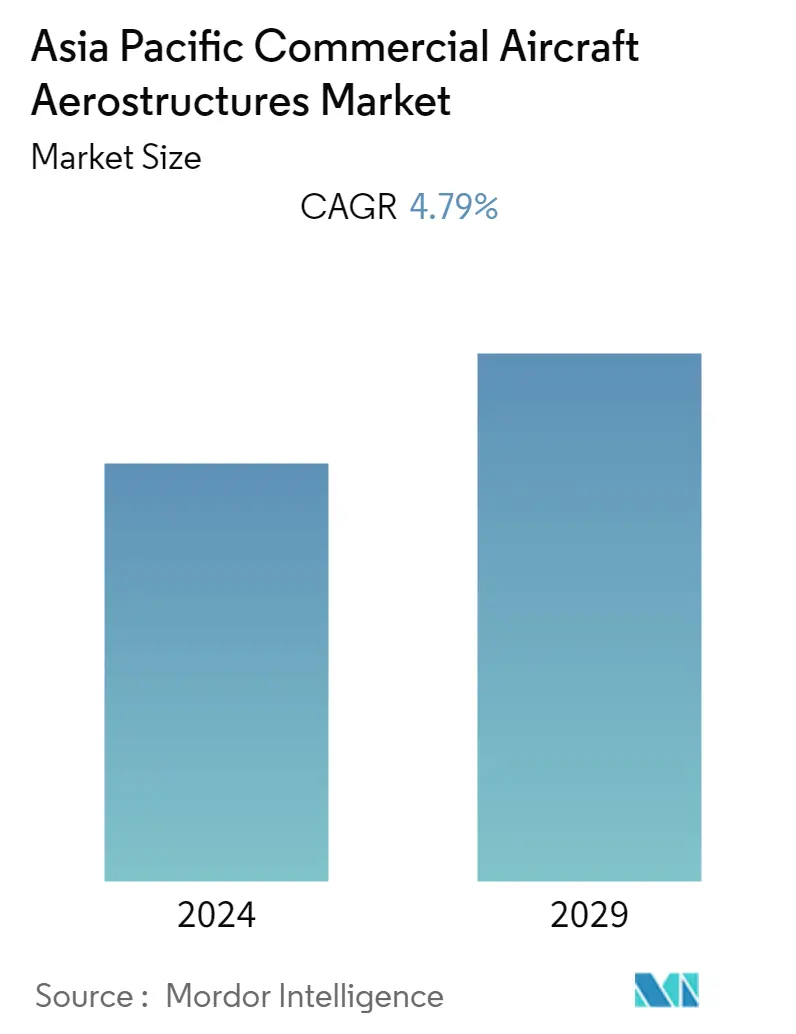Market Size of Asia Pacific Commercial Aircraft Aerostructures Industry

| Study Period | 2020 - 2029 |
| Base Year For Estimation | 2023 |
| Forecast Data Period | 2024 - 2029 |
| Historical Data Period | 2020 - 2022 |
| CAGR | 4.79 % |
| Market Concentration | Medium |
Major Players
*Disclaimer: Major Players sorted in no particular order |
Asia Pacific Commercial Aircraft Aerostructures Market Analysis
- The Asia Pacific commercial aircraft aerostructures market is anticipated to grow at a CAGR of 4.79% during the forecast period.
- The COVID-19 pandemic severely impacted the aviation sector across the Asia Pacific. According to the International Air Transport Association (IATA), Asia-Pacific airlines recorded a revenue decline of USD 113 billion in 2020 compared to the previous year due to the pandemic, which was the largest drop among all regions. However, the market has shown strong signs of recovery post-COVID due to increased air passengers, rising procurement of commercial aircraft, and growing aircraft modernization programs.
- The increase in air passenger traffic has led to a higher demand for new aircraft, which is expected to drive market growth. According to CH Aviation, the global air fleet size increased in 2022, and the active air fleet in September 2022 witnessed a 5% year-on-year growth. The active air fleet in the Asia-Pacific region in September 2022 was 10,894, consisting of 8,695 active and 2,199 aircraft.
- As the aviation industry evolves technologically, aircraft manufacturing companies are researching and developing new, advanced, and composite materials that provide more strength and durability while weighing less. Despite the few restraints mentioned above, the market is expected to grow during the forecast period, given the increasing demand for commercial aircraft.
Asia Pacific Commercial Aircraft Aerostructures Industry Segmentation
An aircraft aerostructure is a separately manufactured unit or component of an aircraft's airframe that includes fuselage, wings, nacelles, and flight control surfaces. Aerostructures together support the aircraft by acting as a skeleton on which other equipment and devices are mounted or integrated.
The Asia Pacific commercial aircraft aerostructures market is segmented by material, end-user, and country. By material, the market is segmented into alloys, composites, and metals. By end-user, the market is segmented into original equipment manufacturer (OEM) and aftermarket. By geography, the market is segmented into China, India, Japan, South Korea, Indonesia, Australia, and the rest of Asia Pacific.
The market sizing and forecasts have been provided in value (USD billion) for all the above segments.
| Material | |
| Alloys | |
| Composites | |
| Metals |
| End User | |
| OEM | |
| Aftermarket |
| Country | |
| China | |
| India | |
| Japan | |
| South Korea | |
| Indonesia | |
| Australia | |
| Rest of Asia-Pacific |
Asia Pacific Commercial Aircraft Aerostructures Market Size Summary
The Asia Pacific commercial aircraft aerostructures market is poised for significant growth, driven by a resurgence in air travel and increased demand for new aircraft. The region has experienced a robust recovery post-COVID, with a notable rise in air passenger traffic and a surge in aircraft procurement and modernization programs. This growth is further supported by technological advancements in aircraft manufacturing, where companies are focusing on developing advanced composite materials that offer enhanced strength and durability while reducing weight. The use of these materials is crucial in aerospace applications, contributing to the efficiency and performance of commercial aircraft. Despite some challenges, the market is expected to expand steadily, fueled by the rising demand for commercial aircraft and their components.
India, in particular, is witnessing a remarkable increase in aircraft manufacturing and commercial aircraft deliveries, bolstered by government support and investments in the aviation sector. The country's aviation market is experiencing a strong recovery, with significant growth in both domestic and international air passenger traffic. This growth is reflected in the substantial orders placed by Indian airlines for new aircraft, aiming to modernize their fleets and capture a larger share of the burgeoning air travel market. The market landscape is moderately fragmented, with key players like Boeing, Airbus, and Lockheed Martin, alongside local entities, focusing on innovation and strategic partnerships to enhance aerostructure performance. These developments are expected to positively impact the commercial aircraft aerostructures market in the region over the forecast period.
Asia Pacific Commercial Aircraft Aerostructures Market Size - Table of Contents
-
1. MARKET DYNAMICS
-
1.1 Market Overview
-
1.2 Market Drivers
-
1.3 Market Restraints
-
1.4 Porter's Five Forces Analysis
-
1.4.1 Threat of New Entrants
-
1.4.2 Bargaining Power of Buyers/Consumers
-
1.4.3 Bargaining Power of Suppliers
-
1.4.4 Threat of Substitute Products
-
1.4.5 Intensity of Competitive Rivalry
-
-
-
2. MARKET SEGMENTATION
-
2.1 Material
-
2.1.1 Alloys
-
2.1.2 Composites
-
2.1.3 Metals
-
-
2.2 End User
-
2.2.1 OEM
-
2.2.2 Aftermarket
-
-
2.3 Country
-
2.3.1 China
-
2.3.2 India
-
2.3.3 Japan
-
2.3.4 South Korea
-
2.3.5 Indonesia
-
2.3.6 Australia
-
2.3.7 Rest of Asia-Pacific
-
-
Asia Pacific Commercial Aircraft Aerostructures Market Size FAQs
What is the current Asia Pacific Commercial Aircraft Aerostructures Market size?
The Asia Pacific Commercial Aircraft Aerostructures Market is projected to register a CAGR of 4.79% during the forecast period (2024-2029)
Who are the key players in Asia Pacific Commercial Aircraft Aerostructures Market?
The Boeing Company, Airbus SE, Lockheed Martin Corporation, Commercial Aircraft Corporation of China (COMAC) and TATA Advanced Systems Ltd. are the major companies operating in the Asia Pacific Commercial Aircraft Aerostructures Market.

